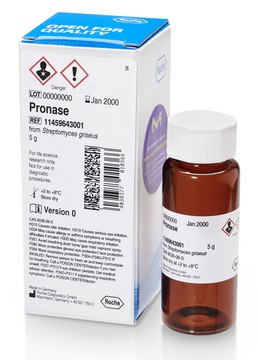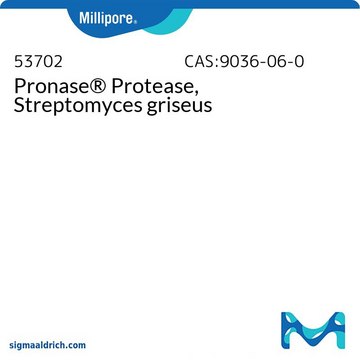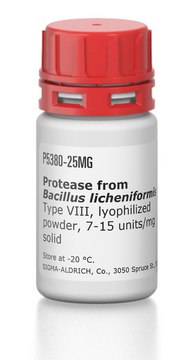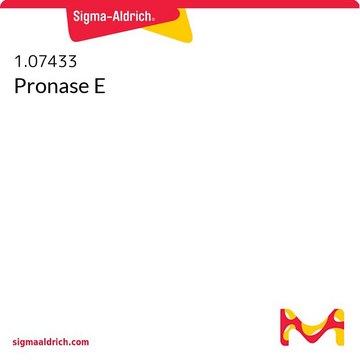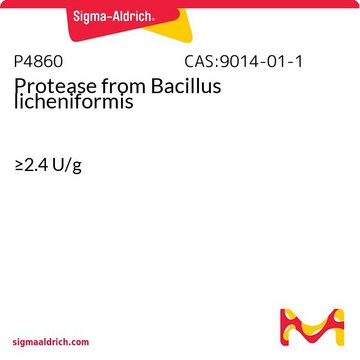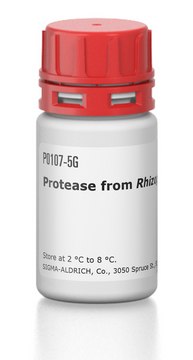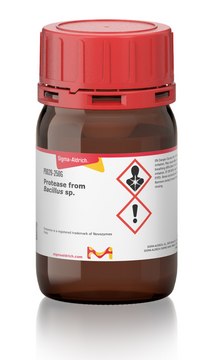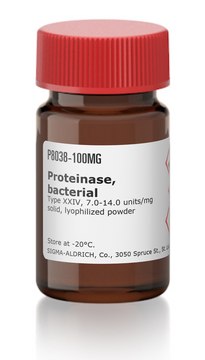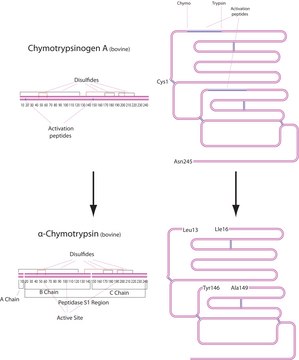P5147
Protease from Streptomyces griseus
Type XIV, ≥3.5 units/mg solid, powder
Synonym(s):
Actinase E, Pronase E
Sign Into View Organizational & Contract Pricing
All Photos(5)
About This Item
CAS Number:
EC Number:
MDL number:
UNSPSC Code:
12352204
eCl@ss:
32160410
NACRES:
NA.54
Recommended Products
biological source
Streptomyces griseus
Quality Level
type
Type XIV
form
powder
specific activity
≥3.5 units/mg solid
solubility
10 mM NaAc (pH 7.5) and 5 mM CaAc: soluble 0.2 mg/mL at 37 °C, clear, colorless to tan
shipped in
wet ice
storage temp.
−20°C
Looking for similar products? Visit Product Comparison Guide
Related Categories
Specificity
A mixture of at least three proteolytic activities including an extracellular serine protease. In general, serine proteases display a wide range of substrate specificities, which are believed to be mediated by an active site composed of one Asp, one His, and a Ser residue in the molecule. This enzyme prefers to hydrolyze peptide bonds on the carboxyl side of glutamic or aspartic acid.
Application
Protease from Streptomyces griseus has been used:
- for the digestion of nucleus pulposus (NP) tissue
- in the catalysis of asymmetric one pot Mannich reaction
- for deproteinization of starch
- digestion of brain slices for the cell dissociation
Protease is an enzyme used to break down proteins by hydrolyzing peptide bonds. Protease is used to degrade proteins, to study protease inhibitors and to study thermal inactivation kinetics. Protease is used in nucleic acid isolation procedures in incubations. Protease from Streptomyces griseus has been used in crystallographic and kinetic investigations of the covalent complex formed by tetrapeptide aldehydes and serine proteases.
Protease is typically used in nucleic acid isolation procedures in incubations of 0.5-3.0 hours supplemented with 0.2% sodium dodecyl sulfate and 10 mM EDTA.
The enzyme from Sigma has been used for the digestion and analysis of antithrombin-heparin complexes. It has also been used for the isolation of enzyme-resistant starch.
This enzyme is more active at a higher pH range than the known alkaline protease, showing the proteolytic activity even in 0.2N NaOH solution. This enzyme is useful for proteolysis of insoluble protein and for structure investigation of protein.
Biochem/physiol Actions
Protease catabolizes proteins by hydrolysis of peptide bonds. Proteases are inactivated by serine active-site inhibitors, such as phenylmethylsulfonyl fluoride (PMSF) and diisopropylfluorophosphate. Protease from Streptomyces griseus is a mixture of at least three proteolytic activities including an extracellular serine protease. Serine proteases display a wide range of substrate specificities, which are believed to be mediated by an active site composed of one Asp, one His, and a Ser residue in the molecule. This enzyme prefers to hydrolyze peptide bonds on the carboxyl side of glutamic or aspartic acid.
This product is a mixture of at least three caseinolytic activities and one aminopeptidase activity. The caseinolytic enzymes were named as Streptomyces griseus Protease A, Streptomyces griseus Protease B and Streptomyces griseus Trypsin. This product may be used when extensive or complete degradation of protein is required. This protease mixture is highly nonspecific and can digest casein to the extent of >70% as mono-amino acids.
Features and Benefits
- highly stable in pH range of 5.0 to 9.0, with peak activity at pH 8.8
- compatible with many DNA and RNA isolation buffers
- broad substrate specificity
Quality
Contains calcium acetate.
Physical properties
Completely inactivated by heating above 80 °C for 15-20 minutes.
Unit Definition
One unit will hydrolyze casein to produce color equivalent to 1.0 μmole (181 μg) of tyrosine per min at pH 7.5 at 37 °C (color by Folin-Ciocalteu reagent).
Preparation Note
Collected from culture broth of S. griseus.
related product
Product No.
Description
Pricing
signalword
Danger
hcodes
Hazard Classifications
Eye Irrit. 2 - Resp. Sens. 1 - Skin Irrit. 2 - STOT SE 3
target_organs
Respiratory system
Storage Class
11 - Combustible Solids
wgk_germany
WGK 2
flash_point_f
Not applicable
flash_point_c
Not applicable
ppe
Eyeshields, Gloves, type N95 (US)
Choose from one of the most recent versions:
Already Own This Product?
Find documentation for the products that you have recently purchased in the Document Library.
Customers Also Viewed
Our team of scientists has experience in all areas of research including Life Science, Material Science, Chemical Synthesis, Chromatography, Analytical and many others.
Contact Technical Service
